Many email marketers use GIFs to add a visual flair that meaningfully engages their readers.
Unlike some other email additions, GIF animations are simple to implement and strongly supported across a variety of devices and email clients.
In this article, you’ll learn how to insert a GIF into a new email and several best practices that will help you increase open rates and conversions. We’ll also share five examples from brands that had success using email GIFs in their marketing campaigns.
What is a GIF?
GIF stands for Graphics Interchange Format and was developed in 1987 by the team at online services provider CompuServe.
GIFs are known for their animation ability. Similar to a brief slideshow or flipbook, animated GIFs work by displaying a series of still images that create the illusion of motion and tend to last anywhere from three to 15 seconds before repeating from the beginning. GIFs have grown into a popular image format due to wide support across browsers and email clients.
The pros and cons of using an animated GIF in email marketing
Consumer trends show that 91% of customers prefer interactive and visual content over text-based or static media. Including an animated GIF file in your email can add an interesting and eye-catching element that goes beyond the static email design.
Video is preferred by subscribers because it simplifies concepts, is easy to digest and helps to build meaningful connections.
It’s somewhat difficult, however, to offer a uniform email video experience across devices and email clients. To adjust for this, many email marketing specialists have turned to GIFs to animate email campaigns.
The benefits of GIFs
Animated GIFs are a great compromise between a static image and a video. Add GIFs to some of your emails to share a brief product demo in your email without the need for long accompanying paragraphs of text, tons of images, or a lengthy explainer video that people in a hurry won’t have time to watch.
Also, given the fact that videos may display differently across email clients and platforms, GIFs are more predictable in terms of click-through rates (CTR).
GIFs are also more eye-catching than static images and can add a personal, engaging and fun touch to your campaign.
The downsides of GIFs
While supported by most email clients (see the full list below), GIFs are not universally supported. This means that if you are using an incompatible email client, it will only display the first frame of the GIF as an image.
Additionally, if not optimized correctly, GIFs may slow email download time (we’ll explain how to optimize GIFs later).
Microsoft Outlook is the main email client that can make sending GIFs in an email message difficult. Microsoft Outlook 2007, 2010 and 2013 don’t support full GIF animations.
How does a GIF in Outlook email work, then? Best practice is to make sure your GIF is optimized to show the key information in the first frame in case the rest gets cut off.
Besides compatibility issues, the only real downside of email GIFs is overusing them to the point of irritation. If you insert a GIF after every single line of copy, your readers may become overwhelmed by the moving images and ignore all of your email text, or stop reading entirely. Supplement your email copy with GIFs, not the other way around.
Compatible desktop clients
Here is a full list of the email desktop clients that support GIFs:
Outlook 2000–2003
Outlook for Mac
Lotus Notes (6, 7, and 8.5)
Apple Mail
Windows 10 Mail
iOS mail
Android (Default)
Android (Gmail)
Android (Gmail IMAP)
Gmail
G Suite
Yahoo! Mail
AOL
Outlook.com
Comcast
Blackberry
Mail.ru Mobile Clients
Freenet.de
T-Online.de
Web.de
GMX.de
SFR.fr
Orange.fr
At the time of writing, some parties report partial support from Windows users operating Outlook.
How to send a GIF in an email
When figuring out how to email GIFs, you have three primary options.
The first option is to upload inline HTML code into the body of the email. Once you choose what GIF you’d like to use, copy and paste the correct code into the HTML code section of your email builder template.
The second option, if you’re working out how to insert GIFs into email, is to use a drag-and-drop email-building tool, like Campaigns by Pipedrive, as you compose the email.
Adding GIFs in email is so common that many email marketing services allow you to drag and drop a GIF into your email the same way you would with any image.
In most email clients, you can add email GIFs by clicking “insert photo” in your draft or email template. This “click insert” function allows you to insert a GIF file stored on your computer and embed it directly into your email body.
Pro Tip: Do not send a GIF as an attachment because it will not display properly.
Where to get email GIFs
Giphy is home to one of the internet’s biggest GIF collections. Giphy’s GIF Maker enables you to create your own GIFs directly from online pictures, video files or YouTube links.
The tool allows you to insert the image URL, choose where in the video to start the GIF animation, set the GIF duration and add a custom caption.
Gfycat is also a popular GIF site from a hosting perspective. They provide GIF and HTML5 videos with the goal of giving users faster delivery and more playback options.
Pro Tip: When using a GIF image that you don’t own (i.e. you didn’t create or purchase the rights to use it), make sure your GIF is covered under Fair Use and always cite your source.
How to make your own GIFs for email
If you’d prefer to make a custom GIF, Adobe Photoshop has the tools needed to create text-only GIFs, video GIFs and stop-motion GIFs.
Creating your own perfect GIFs in Photoshop naturally takes longer to implement than using a pre-made GIF, but the freedom to create something specific and unique to your brand is well worth the wait.
In the long run, branded GIFs are better for brand awareness and visibility as you can customize them with your unique colors, fonts and images in a way that will make a more meaningful impression with your audience.
GIF alternatives
Some marketers find GIF creation too complex or time-consuming, or they worry about the GIF file size slowing down the load speed. In these cases, there are other ways to add motion to your email marketing without using GIFs.
One option is to use animated PNG files called APNGs. Animated PNGs work similarly to GIFs, with the extra bonus of having better support for transparency.
GIFs can be transparent, but they tend to introduce a white outline to graphics that can look messy on dark backgrounds. In contrast, APNGs can offer a cleaner look to your message. That said, APNGs aren’t as widely supported as animated GIFs, so make sure to test and preview before sending your campaign.
CSS animations are another alternative to GIFs. By using CSS properties, you can create animations from a variety of HTML elements and images. CSS animations are best used for simple animations such as slide-ins and fades. CSS animations also fallback more neatly (return to the preferred option) than GIFs when not supported.
Ideas on how to use GIFs effectively in your email marketing
Here are some ideas on how best to insert GIFs in email marketing campaigns:
Use GIFs to provide a preview of other content
GIFs can be used to provide a preview of other linked content, such as a full video, infographic or new blog post.
You can add URLs to GIFs to link them to your website, social media accounts, landing pages and other marketing channels.
Use GIFs as a mini-explainer video
Instead of writing a long step-by-step paragraph of instructions, you can create a GIF that lays out the process.
For example, if you created a new feature in your SaaS tool, you could include a GIF that shows your audience exactly how to use it.
Show a product in action
Sometimes, announcing a new product is not enough. A GIF can help your subscribers visualize how they might actually use the product themselves. A quick demo of the product can entice subscribers to click through and learn more.
Add a reaction GIF
Reaction GIFs in your email can entertain your readers, provide relevant humor, or express how you feel about something.
For example, you could add a GIF that shows excitement about a new offer. GIF reactions are similar to emojis in the sense that they must align with your target audience and brand.
Do research to ensure that your audience will enjoy this type of playful GIF before using it to ensure it will be well received.
GIF best practices
There are a few best practices to keep in mind when it comes to successfully executing email marketing campaigns with GIFs.
Keep file size to a minimum
Your email GIFs should be no bigger than 1MB. An oversized image can affect load time or even misalign your email design and formatting. To reduce the file size of your GIF, you have a few options:
Crop your GIF. See if there are sections of the image you can crop to make it smaller.
Use “save for web” export. In most design programs, you can opt to “save for web”, which tends to reduce the file size by stripping metadata while still retaining size and quality. To use this, click “File”, “Export” then “Save for Web”.
Decrease the number of frames. The illusion of motion can be made with a small number of frames. See how many you can remove while still retaining the animation effect. Aim for under 200 frames, or even 100 if possible.
Only animate one layer of the picture. By using layers in Photoshop, you can isolate the animated section of the image so the entire frame doesn’t need to reload. This can be used for simple things like a ribbon unwrapping, a flickering fire or a watch ticking, for example.
Reduce the number of colors used. Depending on your GIF, you may be able to reduce the number of colors used without impacting the visual quality. Best practice is to try to ensure your GIF has 64 colors or fewer. In Photoshop, you can choose from perceptual, selective, or adaptive color reduction algorithm options to reduce the color in certain ways.
Remember mobile users
When figuring out how to send GIFs in email, keep in mind that mobile devices can alter email design and display everything at a smaller size. Avoid adding too much text to your GIF so that it’s still easy to understand on a variety of devices.
In addition, a large GIF can also consume people’s phone data. To minimize this outcome, tools like Giphy’s mobile applications can optimize the content, which sometimes results in subtle changes to the GIF’s size and speed.
Make sure to test your email GIFs on mobile to ensure they perform at optimal levels before sending them out to your entire subscriber list.
Keep your GIFs accessible
To ensure your GIF is accessible to all audiences, make sure to set the GIF to stop after five seconds and ensure there is a way for users to pause the GIF.
Additionally, content flashing rates between 2 Hz and 55 Hz can be harmful to users with photosensitive epilepsy. To ensure your GIF is safe for those who are photosensitive, use this Photosensitive Epilepsy Analysis Tool.
Users who are visually impaired may also have difficulty reading or reviewing content on a GIF before the animation changes. Ensure your animated GIFs either have smooth transitions or don’t animate from one frame to the next at a high rate.
Since GIFs are image files, you should include alternative text (or alt text) so that users who rely on assistive technology like screen readers can understand your message.
Add a call to action in your GIF
Make sure your GIFs support your marketing goals by including a call to action (CTA). Depending on your goals, you might ask them to make an account, return to their cart, request a free quote or refer a friend to your business, for example.
Don’t overdo it
If you use GIFs too often, subscribers may tire of them and become less likely to engage with your campaigns. Be deliberate about when to insert GIFs into your email campaigns so you continue to surprise and delight your subscribers.
Overall, make sure the GIF serves a specific purpose. If you believe you can communicate your message without a GIF, it might be best to leave it out. Do market research to ensure GIFs are appropriate for your audience and gather insights from your competitor’s email marketing.
5 examples from brands who have used GIFs in their email marketing
Here are five great examples of GIFs in email marketing from brands who’ve nailed it.
Dell’s Ultrabook versatility
Dell’s use of a GIF in 2012 to promote the Dell Ultrabook is commonly cited as one of the best examples of using GIFs in your email marketing campaign.
The GIF demonstrates how the laptop can be turned into a tablet based on a new screen swivel feature.
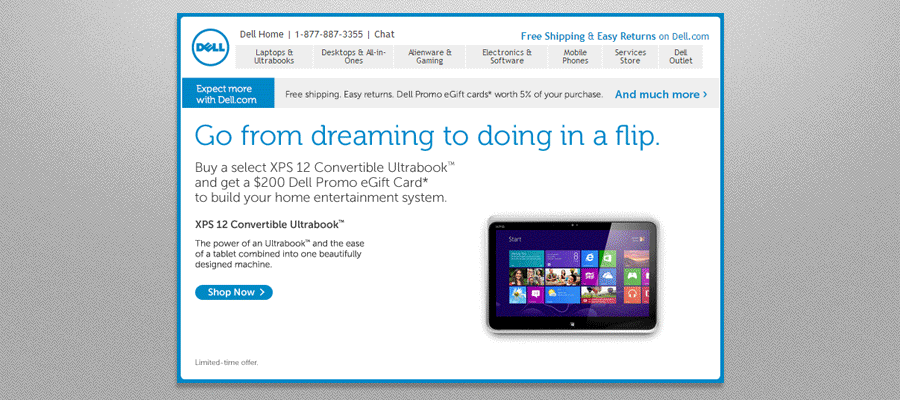
By showing the versatile nature of the product through a GIF, Dell earned a 6% increase in its open rate on the campaign, a 42% jump in its click rate and a 103% increase in its conversion rate.
Nike printed tights promotion
Nike wanted to demonstrate the variety of prints and patterns they offer for running tights. To bring the tights to life, Nike used a GIF to showcase the same model in a variety of prints.
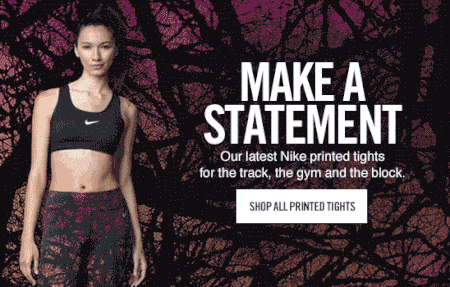
Upon first look, the GIF looks like an image. After a moment, the GIF animates and shows a new pair of tights that catches the eye and keeps readers engaged.
Lyft order process
Lyft wanted to showcase its app update that was designed to have a cleaner user interface that made it easier to order a car.
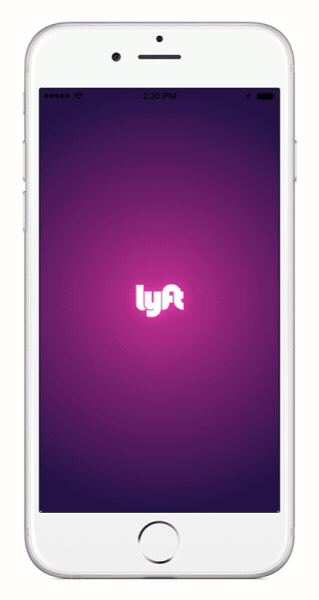
By using a GIF in their email, Lyft was able to clearly demonstrate the simple two-step process of ordering a car. This GIF encourages readers to return to Lyft and explore the app’s new design and offerings.
West Elm lighting sale
The furniture company West Elm needed a way to promote its lighting sale. Its email GIF shows a lamp shining a light on copy that says, “It’s on! 20% off Lighting”.
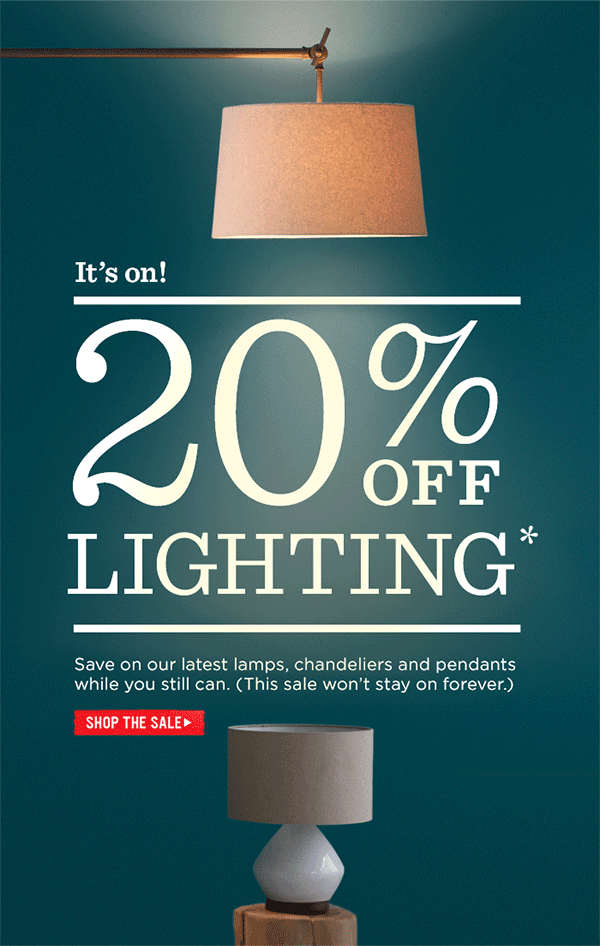
The GIF effect is simple yet brilliantly draws attention to the copy. The GIF ends with an effective call to action that says, “Shop the Sale”.
Sprout Social
Sprout Social wanted to demonstrate how to use its new Sprout Publishing Calendar so the team created an email GIF that previews the new tool and its features.
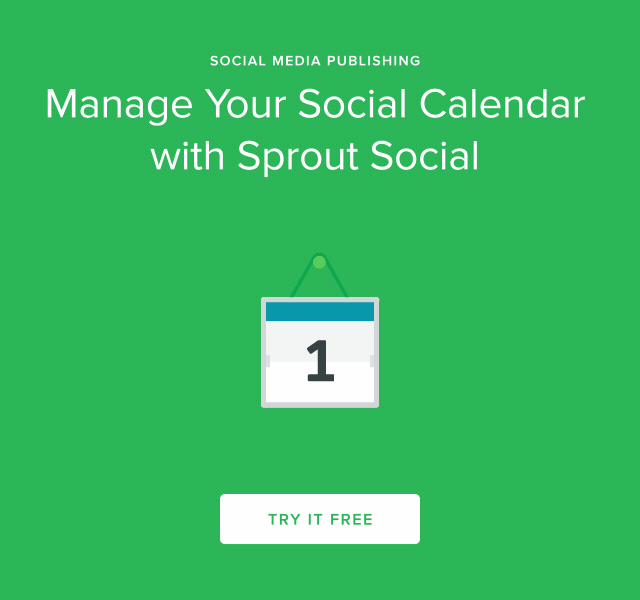
The GIF shows that the calendar can be viewed at a glance, that you can add details to each item and that you can queue posts in advance. It’s a quick preview, but it’s enough to get people interested in clicking through to learn more.
Final thoughts
With an ROI of 42:1, email marketing is more effective than ever and continues to significantly outperform other marketing channels. Given its effectiveness, many marketers are competing for attention in their customers’ and leads’ inboxes.
Give GIFs a try and see how they convert for your next email marketing campaign.









